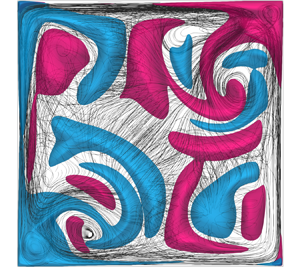Published online by Cambridge University Press: 16 November 2023

Quasistatic magnetoconvection of a fluid with low Prandtl number ( ${\textit {Pr}}=0.025$) with a vertical magnetic field is considered in a unit-aspect-ratio box with no-slip boundaries. At high relative magnetic field strengths, given by the Hartmann number
${\textit {Pr}}=0.025$) with a vertical magnetic field is considered in a unit-aspect-ratio box with no-slip boundaries. At high relative magnetic field strengths, given by the Hartmann number  ${\textit {Ha}}$, the onset of convection is known to result from a sidewall instability giving rise to the wall-mode regime. Here, we carry out three-dimensional direct numerical simulations of unprecedented length to map out the parameter space at
${\textit {Ha}}$, the onset of convection is known to result from a sidewall instability giving rise to the wall-mode regime. Here, we carry out three-dimensional direct numerical simulations of unprecedented length to map out the parameter space at  ${\textit {Ha}} = 200, 500, 1000$, varying the Rayleigh number (
${\textit {Ha}} = 200, 500, 1000$, varying the Rayleigh number ( ${\textit {Ra}}$) over the range
${\textit {Ra}}$) over the range  $6\times 10^5 \lesssim {\textit {Ra}} \lesssim 5\times 10^8$. We track the development of stable equilibria produced by this primary instability, identifying bifurcations leading to limit cycles and eventually to chaotic dynamics. At
$6\times 10^5 \lesssim {\textit {Ra}} \lesssim 5\times 10^8$. We track the development of stable equilibria produced by this primary instability, identifying bifurcations leading to limit cycles and eventually to chaotic dynamics. At  ${\textit {Ha}}=200$, the steady wall-mode solution undergoes a symmetry-breaking bifurcation producing a state that features a coexistence between wall modes and a large-scale roll in the centre of the domain, which persists to higher
${\textit {Ha}}=200$, the steady wall-mode solution undergoes a symmetry-breaking bifurcation producing a state that features a coexistence between wall modes and a large-scale roll in the centre of the domain, which persists to higher  ${\textit {Ra}}$. However, under a stronger magnetic field at
${\textit {Ra}}$. However, under a stronger magnetic field at  ${\textit {Ha}}=1000$, the steady wall-mode solution undergoes a Hopf bifurcation producing a limit cycle which further develops to solutions that shadow an orbit homoclinic to a saddle point. Upon a further increase in
${\textit {Ha}}=1000$, the steady wall-mode solution undergoes a Hopf bifurcation producing a limit cycle which further develops to solutions that shadow an orbit homoclinic to a saddle point. Upon a further increase in  ${\textit {Ra}}$, the system undergoes a subsequent symmetry break producing a coexistence between wall modes and a large-scale roll, although the large-scale roll exists only for a small range of
${\textit {Ra}}$, the system undergoes a subsequent symmetry break producing a coexistence between wall modes and a large-scale roll, although the large-scale roll exists only for a small range of  ${\textit {Ra}}$, and chaotic dynamics primarily arise from a mixture of chaotic wall-mode dynamics and arrays of cellular structures.
${\textit {Ra}}$, and chaotic dynamics primarily arise from a mixture of chaotic wall-mode dynamics and arrays of cellular structures.